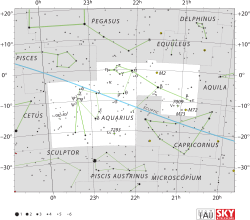86 Aquarii

| |
| Observation data Epoch J2000 Equinox J2000 | |
|---|---|
| Constellation | Aquarius |
| Right ascension | 23h 06m 40.84483s[1] |
| Declination | –23° 44′ 35.2344″[1] |
| Apparent magnitude (V) | +4.47[2] |
| Characteristics | |
| Spectral type | G8 III[3] |
| U−B color index | +0.58[2] |
| B−V color index | +0.90[2] |
| Astrometry | |
| Radial velocity (Rv) | +15.2[4] km/s |
| Proper motion (μ) | RA: +58.86[1] mas/yr Dec.: –1.74[1] mas/yr |
| Parallax (π) | 15.08 ± 0.72[1] mas |
| Distance | 220 ± 10 ly (66 ± 3 pc) |
| Details | |
| Surface gravity (log g) | 3.10[5] cgs |
| Temperature | 4,900[5] K |
| Metallicity [Fe/H] | –0.14[5] dex |
| Other designations | |
86 Aquarii is the Flamsteed designation for a binary star[7] system in the equatorial constellation of Aquarius. It is faint but visible to the naked eye with an apparent visual magnitude of +4.47.[2] Based upon parallax measurements, the distance to this star is about 220 light-years (67 parsecs).[1]
The two components of this system have an angular separation of 0.25 arcseconds.[7] The brighter component is a giant star with a spectral classification of G8 III[3] and an apparent magnitude of 4.79.[7] The effective temperature of its outer atmosphere is 4,900 K,[5] giving it the yellowish glow of a G-type star.[8] The fainter component is a star of magnitude 6.77.[7]
References
- ↑ 1.0 1.1 1.2 1.3 1.4 1.5 van Leeuwen, F. (November 2007), "Validation of the new Hipparcos reduction", Astronomy and Astrophysics 474 (2): 653–664, arXiv:0708.1752, Bibcode:2007A&A...474..653V, doi:10.1051/0004-6361:20078357.
- ↑ 2.0 2.1 2.2 2.3 Nicolet, B. (1978), "Photoelectric photometric Catalogue of homogeneous measurements in the UBV System", Astronomy and Astrophysics Supplement Series 34: 1–49, Bibcode:1978A&AS...34....1N.
- ↑ 3.0 3.1 Houk, Nancy (1978), Michigan catalogue of two-dimensional spectral types for the HD stars 4, Ann Arbor: Dept. of Astronomy, University of Michigan, Bibcode:1988mcts.book.....H.
- ↑ Wilson, Ralph Elmer (1953), General Catalogue of Stellar Radial Velocities, Washington: Carnegie Institution of Washington, Bibcode:1953QB901.W495......
- ↑ 5.0 5.1 5.2 5.3 McWilliam, Andrew (December 1990), "High-resolution spectroscopic survey of 671 GK giants. I - Stellar atmosphere parameters and abundances", Astrophysical Journal Supplement Series 74: 1075–1128, Bibcode:1990ApJS...74.1075M, doi:10.1086/191527.
- ↑ "86 Aqr -- Star", SIMBAD (Centre de Données astronomiques de Strasbourg), retrieved 2012-07-13.
- ↑ 7.0 7.1 7.2 7.3 Eggleton, P. P.; Tokovinin, A. A. (September 2008). "A catalogue of multiplicity among bright stellar systems". Monthly Notices of the Royal Astronomical Society 389 (2): 869–879. arXiv:0806.2878. Bibcode:2008MNRAS.389..869E. doi:10.1111/j.1365-2966.2008.13596.x.
- ↑ "The Colour of Stars", Australia Telescope, Outreach and Education (Commonwealth Scientific and Industrial Research Organisation), December 21, 2004, retrieved 2012-01-16
External links
| ||||||||||||||||||||||||||||||||||||||||||||||||||||||||||||||